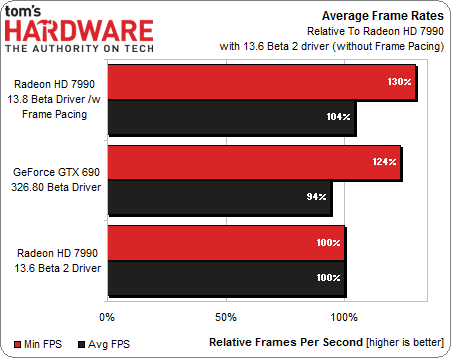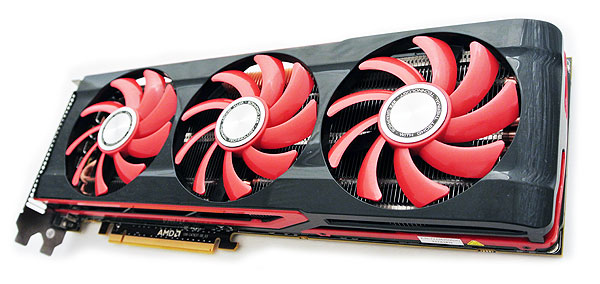Dual-GPU Battle: Does Frame Pacing In Catalyst 13.8 Turn The Tide?
We take AMD's Catalyst 13.8 beta driver for a spin to see if its frame pacing feature fixes CrossFire's dropped and runt frame issues. Follow along as we compare the Radeon HD 7990 to Nvidia's GeForce GTX 690 in seven popular titles, with video to match!
Mo' Data, Mo' Problems: Use Every Tool For A Better Conclusion
Before we come to any conclusions, here are the average frame rates and minimum frame rates, per FCAT. We aren't expecting performance to change dramatically based on AMD's frame pacing driver. However, because metering out frames helps eliminate drops and runts, effective frame rate should go up with Catalyst 13.8.
We're leaving the Metro: Last Light numbers out of this summary. While it's true that there's a very real problem affecting AMD in that game, and you should know about it, we don't want it throwing off our comparison of the other titles.
The minimum frame rates, especially, look a lot better under Catalyst 13.8 with frame pacing. If this was the only thing we were interested in evaluating, we'd congratulate AMD on a job well done and call it a day.
But as it turns out, things get a little more complicated when we add side-by-side comparisons of the videos used to generate our quantitative data. We had hoped that the results from FCAT would clearly correspond to the gaming output used to create them. This would have made FCAT a Holy Grail for objectively describing the experience you get from gaming on any combination of graphics cards.
The problem we encountered is that, in some cases, the video appears to conflict (or at least fail to confirm) the benchmark numbers generated by FCAT. I think we have an explanation for Far Cry 3, but the Tomb Raider and Battlefield 3 videos aren't readily complementary of the data. As we're sure you can imagine, any challenge in relating benchmarks to real experiences forcibly calls into question the value of the numbers, even if they're completely correct.
It would appear, then, and perhaps not surprisingly, that the only mechanism we can fully trust when it comes to evaluating performance is our eyes. To facilitate this, we have side-by-side video comparisons. Unfortunately, we don't get tidy numbers to encapsulate the results. Sometimes we don't even end up with agreeing opinions. So, benchmark numbers remain an important component of our reviews; they aren't going anywhere. But it's important to acknowledge that there's more to this story than average frame rates. Side-by-side video comparisons are important, too.
What conclusions can we draw about AMD's Catalyst 13.8 driver, then? First, we applaud the company for addressing frame pacing, and we look forward to the second phase of its driver release that'll add OpenGL, Eyefinity, and DirectX 9 support. It's encouraging that FCAT reports significantly lower frame time variance using the new driver. Conversely, it's also clear that AMD needs to fix a problem with Metro: Last Light. While it's a bummer that there are still outstanding issues, at least we know the company's working to fix the problems reported in CrossFire.
Get Tom's Hardware's best news and in-depth reviews, straight to your inbox.
What about the Radeon HD 7990 specifically, now that it's selling for $700? The card is certainly more attractive after the price cut, and AMD's Never Settle eight-game bundle is pretty awesome for folks who don't already own its contents. Although the Radeon HD 7990 is more power-hungry than the GeForce GTX 690, and arguably nowhere near as elegant, a $300 premium on the dual-GK104 card makes it a bit easier to live with some of the 7990's persistent quirks. It seems clear that the GeForce GTX 690 delivers more consistent performance. But more so than ever before, AMD's dual-GPU card is at least a contender now.
At the end of the day, though, we'd still be most inclined to recommend two Radeon HD 7970s in CrossFire or two GeForce GTX 770s in SLI ahead of either dual-GPU board. With that said, now we need to determine if the rest of AMD's cards are equally affected by Catalyst 13.8 when we pair them up. Looks like it's time for some more benchmarking...
Current page: Mo' Data, Mo' Problems: Use Every Tool For A Better Conclusion
Prev Page Results: Battlefield 3Don Woligroski was a former senior hardware editor for Tom's Hardware. He has covered a wide range of PC hardware topics, including CPUs, GPUs, system building, and emerging technologies.
-
jimmysmitty The drivers do seem to make the FPS much smoother overall. BF3 is a good example with the game dropping then jumping and so on but 13.8 made it a much smoother line.Reply
Its good to see that work is being done to make it more competitive but I fear that its almost pointless since Hawaii XT is on its way and will be a better option in CFX.
Also Laras hair on the GTX690 was funny. Just fluttering around like crazy. I guess TressFX does make a difference after all. -
jase240 This is great, AMD is finally getting on par for dual GPU config with Nvidia!!Reply
This might make 2 AMD cards a way better value than Nvidia!! -
viewgamer The Metro Last Light benchmark is a modern example of the way Nvidia handles its business.Reply
These strong arm tactics to eliminate the competition aren't beneficial to anyone, Nvidia's less than pleasant business practices is why I try to support AMD whenever possible. -
viewgamer The Metro Last Light benchmark is a modern example of the way Nvidia handles its business.Reply
These strong arm tactics to eliminate the competition aren't beneficial to anyone, Nvidia's less than pleasant business practices is why I try to support AMD whenever possible. -
Emma Long Apart from Metro the 7990 tied the 690 on two occasions and beat it in the rest, that's very encouraging from the red team.Reply
The situation with Metro last light seems peculiar to me, we've seen things like this before with Nvidia sponsored titles & I thought the industry was passed this sort of thing.
Nvidia can compete, it has proven so time and time again, which makes this all the more reprehensible.
I would like to see an Nvidia that competes on the basis of performance & features not strong-arming developers.
Back to the 7990, so overall it's faster than the 690 and significantly less expensive, at $700 the 7990 puts very serious pressure on the 780 so I'd like to see the 780 added into the benchmarking mix as well. -
CarlitoBanderas What's the point of a 690 ? in 1080o & 1440p it's slower than the 7990, in 4K & multi monitor it doesn't have enough memory & it's 300 bucks more expensive.Reply
Nvidia needs to bring out a 790 asap, the 690 is not competitive anymore. -
m32 I've enjoyed this article, Toms. We've seen the flaws and now some improvements with the 7990.Reply -
aggroboy Reply
Enthusiast mindshare is still dominated by the GTX Titan, so Nvidia can afford to stand pat.11476339 said:What's the point of a 690 ? in 1080o & 1440p it's slower than the 7990, in 4K & multi monitor it doesn't have enough memory & it's 300 bucks more expensive.
Nvidia needs to bring out a 790 asap, the 690 is not competitive anymore.

